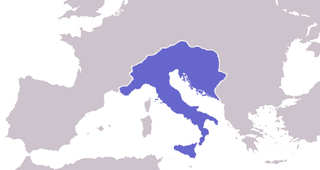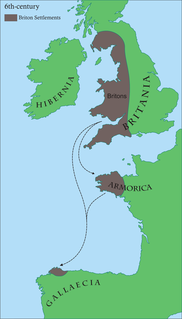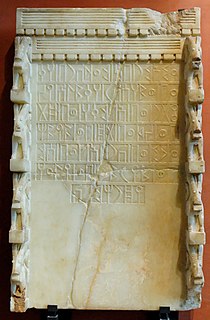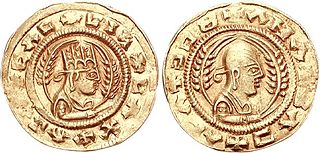
Theodoricthe Great, also called Theodoric the Amal, was king of the Ostrogoths (471–526), and ruler of the independent Ostrogothic Kingdom of Italy between 493–526, regent of the Visigoths (511–526), and a patrician of the East Roman Empire. As ruler of the combined Gothic realms, Theodoric controlled an empire stretching from the Atlantic Ocean to the Adriatic Sea. Though Theodoric himself only ever used the title 'king' (rex), some scholars characterize him as a Western Roman Emperor in all but name, since he ruled large parts of the former Western Roman Empire, had received the former Western imperial regalia from Constantinople in 497, and was referred to by the title augustus by some of his subjects.
The 520s decade ran from January 1, 520, to December 31, 529.
The 480s decade ran from January 1, 480, to December 31, 489.

Year 451 (CDLI) was a common year starting on Monday of the Julian calendar. At the time, it was known as the Year of the Consulship of Marcianus and Adelfius. The denomination 451 for this year has been used since the early medieval period, when the Anno Domini calendar era became the prevalent method in Europe for naming years.

Year 493 (CDXCIII) was a common year starting on Friday of the Julian calendar. At the time, it was known as the Year of the Consulship of Albinus and Eusebius. The denomination 493 for this year has been used since the early medieval period, when the Anno Domini calendar era became the prevalent method in Europe for naming years.

Year 500 (D) was a leap year starting on Saturday of the Julian calendar. At the time, it was known as the Year of the Consulship of Patricius and Hypatius. The denomination 500 for this year has been used since the early medieval period, when the Anno Domini calendar era became the prevalent method in Europe for naming years. The year 500 is considered the beginning of the Middle Ages, approximately.

Year 510 (DX) was a common year starting on Friday of the Julian calendar. At the time, it was known as the Year of the Consulship of Severinus without colleague. The denomination 510 for this year has been used since the early medieval period, when the Anno Domini calendar era became the prevalent method in Europe for naming years.
Year 525 (DXXV) was a common year starting on Wednesday of the Julian calendar. At the time, it was known as the Year of the Consulship of Probus and Philoxenus. The denomination 525 for this year has been used since the early medieval period, when the Anno Domini calendar era became the prevalent method in Europe for naming years. In this year, the monk Dionysius Exiguus proposed a calendar starting with the birth of Jesus, so this was the first time the year was designated AD. However, the system was not used in general until the reign of Charlemagne in the 9th century.

Year 520 (DXX) was a leap year starting on Wednesday of the Julian calendar. At the time, it was known as the Year of the Consulship of Rusticus and Vitalianus. The denomination 520 for this year has been used since the early medieval period, when the Anno Domini calendar era became the prevalent method in Europe for naming years.
Year 521 (DXXI) was a common year starting on Friday of the Julian calendar. At the time, it was known as the Year of the Consulship of Sabbatius and Valerius. The denomination 521 for this year has been used since the early medieval period, when the Anno Domini calendar era became the prevalent method in Europe for naming years.

The Himyarite Kingdom, or Himyar, historically referred to as the Homerite Kingdom by the Greeks and the Romans, was a polity in the southern highlands of Yemen, as well as the name of the region which it claimed. Until 110 BCE, it was integrated into the Qatabanian kingdom, afterwards being recognized as an independent kingdom. According to classical sources, their capital was the ancient city of Zafar, relatively near the modern-day city of Sana'a. Himyarite power eventually shifted to Sana’a as the population increased in the fifth century.
Dhū Nuwās,, real name "Yūsuf Asʾar Yathʾar", "Yosef Nu'as", or "Yūsuf ibn Sharhabīl", also known as "Masruq" in Syriac, and Dounaas (Δουναας) in Medieval Greek, was a Jewish king of Himyar between 517 and 525–527 C.E., who came to renown on account of his persecutions of peoples of other religions, notably Christians, living in his kingdom.
Abraha, also known as Abraha al-Ashram, was an Aksumite army general, then the viceroy of southern Arabia for the Kingdom of Aksum, and later declared himself an independent King of Himyar. Abraha ruled much of present-day Arabia and Yemen from at least 531–547 CE to 555–570 CE.

The ancient history of Yemen is especially important because Yemen is one of the oldest centers of civilization in the Near East. Its relatively fertile land and adequate rainfall in a moister climate helped sustain a stable population, a feature recognized by the ancient Greek geographer Ptolemy, who described Yemen as Eudaimon Arabia meaning Fortunate Arabia or Happy Arabia. Between the eighth century BCE and the sixth century CE, it was dominated by six main states which rivaled each other, or were allied with each other and controlled the lucrative spice trade: Saba', Ma'īn, Qatabān, Hadhramaut, Kingdom of Awsan, and the Himyarite Kingdom. Islam arrived in 630 CE and Yemen became part of the Muslim realm.
The Jewish tribes of Arabia were ethnic groups professing the Jewish faith that inhabited the Arabian Peninsula before and during the advent of Islam. In Islamic tradition, the Jewish tribes of the Hejaz were seen as the offspring of the ancient Hebrews. According to historical Muslim sources, they spoke a language other than Arabic, which al-Tabari claims was Persian. This implies they were connected to the major Jewish community of Babylonia. Certain Jewish traditions record the existence of nomadic tribes such as the Rechabites, which converted to Judaism in antiquity.

The Kingdom of Aksum, also known as the Kingdom of Axum or the Aksumite Empire, was an ancient Ethiopian kingdom that spanned what are now Eritrea, northern Ethiopia, much of eastern Sudan and southern/eastern Yemen at its peak. It was centralized in Northern Ethiopia, with its capital in the city of Aksum or Axum. Aksumite rulers styled themselves as King of kings, king of Aksum, Himyar, Raydan, Saba, Salhen, Hamasein, Sarawi, Tsiyamo, Beja, Barya, Hassa and of Kush. Ruled by the Aksumites, it existed from approximately 80 BC to AD 825. The polity was centered in the city of Aksum and grew from the proto-Aksumite Iron Age period around the 4th century BC to achieve prominence by the 1st century AD. Aksum became a major player on the commercial route between the Roman Empire and Ancient India. The Aksumite rulers facilitated trade by minting their own Aksumite currency, with the state establishing its hegemony over the declining Kingdom of Kush. It also regularly entered the politics of the kingdoms on the Arabian Peninsula and eventually extended its rule over the region with the conquest of the Himyarite Kingdom. The Manichaei prophet Mani regarded Aksum as one of the four great powers of his time, the others being Persia, Rome and China. It ruled the South Arabia of Yemen for half a century in the 6th century.
The existence of a Christian community in the city of Najran is attested by several historical sources of the Arabian peninsula, where it recorded as having been created in the 5th century CE or perhaps a century earlier. According to the Arab Muslim historian Ibn Ishaq, Najran was the first place where Christianity took root in South Arabia.

In the late sixth century, Sasanian Empire of Persia and the Ethiopia-based Axumite Empire fought a series of wars over control of the Himyarite Kingdom in Yemen, Southern Arabia. After the Battle of Hadhramaut and the Siege of Sana'a in 570, the Aksumites were expelled from the Arabian peninsula. They had re-established their power there by 575 or 578, when another Persian army invaded Yemen and re-established the deposed king on his throne as their client. It marked the end of Ethiopian rule in Arabia.

The Al–Qalis Church, Sana'a was a Miaphysite church constructed sometime between 527 and the late 560s in the city of Sana'a in modern-day Yemen. The church's lavish decorations made it an important place of pilgrimage, placing it in competition with Kaaba in Mecca.
SumyafaʿAshwaʿ was the king of Ḥimyar under the Aksumite Empire from 525/531 until 535.











